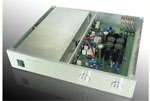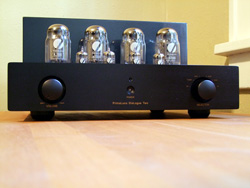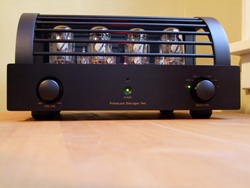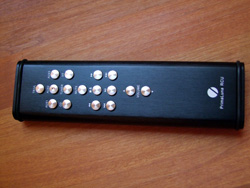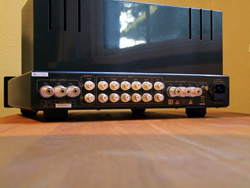Introduction
The PrimaLuna brand needs no introduction to the tube-loving community, but I do (did). Though I’ve heard plenty of good sounding tube gear at shops, at various friends’ houses and of course at shows, I generally listen to solid state equipment. So, having the PrimaLuna Dialogue Two here for review was a new, and very pleasant experience.
From what I can tell, the most strenuous tube advocates listen primarily to Jazz. They can tell you all John Coltrane and even about the difference between a KT88 and 300B, but mention M83 and Four-tet and they might think you are trying to sound smart by making up heretofore unknown tube types.
I don’t need any convincing about the sweet sound of tubes though. As a kid, tube gear was all I heard. Everyone on the block had a tube powered console stereo. I think ours had the best sound. My neighbors were fond of playing Alice Cooper on theirs, so loud that the proper listening level was found about a half block away. Yes tubes can play loud. And the half block soundstage indicates that tube amplifiers definitely can have headroom.
In spite of my solid state bias, PrimaLuna fearlessly offered for review their DiaLogue Two integrated. PrimaLuna designs their products at the headquarters in The Netherlands, builds them in China and sells them in the US through a number of dealers.
Specifications
- Design: Two Channel Integrated Tube Amplifier with Home Theater Pass-Through
- Power Output: 38 Watts/Channel Ultralinear Mode; 21 Watts/Channel Power Triode Mode
- Tube Compliment: 4xKT-88, 2x12AX7, 2x12AU7
- MFR: 10 Hz – 30 kHz ± 1dB
- THD: <0.22% @ 1 Watt, <1.2% at Rated Output
- S/N Ratio: 89 dB
- Input Impedance: 100 kOhm
- Gain (Max) 36.5 dB
- Dimensions: 8.3″ H x 15.2″ W x 15.9″ D
- Weight: 70.5 Pounds
- MSRP: $2,625 USA; Optional PhonoLogue MM Phonostage: $199 USA
- PrimaLuna USA
Design
This amp has the same form factor as previous PrimaLuna products, basically a black square with the tubes neatly exposed and arranged in the front, optionally covered with a protective cage and a black or silver face plate. The KT88 tubes look awesome and imposing, tubes of these proportions give me a comforting feeling that my music is being given its proper due.
Front and center on the ‘tube deck’ is an indicator light that glows red when the amp is in Ultralinear Mode, green for Triode Mode. The modes can be switched via the remote, while music is playing. NEAT! As the manual describes, Ultralinear will play louder and exert more control over the speakers. Triode Mode is said to be ‘Warmer on top and bottom, a little compressed with the midband more pronounced’. I found that I had to have that greater control of Ultralinear mode. More on that later.
One of the reasons I’ve been a solid state guy rather than a “tube roller” is the maintenance. I have always been under the impression that tubes are high maintenance. Relative to solid state anyway, which is no (or not very much) maintenance. I know this is part of the fun, but I just haven’t gone there. Not yet anyway. PrimaLuna addresses part of the tube maintenance issue with their “Adaptive AutoBias” circuit. This circuit does away with the need for user adjustment of the grid bias voltage, and this keeps the tube signal output at its optimum. Another issue is that tubes can “blow” when you turn on a tube amp with the initial surge of current – called an inrush – that occurs. It’s like when you sometimes turn on a room light, and the bulb filament flashes and burns out. Well, PrimaLuna has addressed this problem too. When you turn the amplifier on, the voltage is slowly ramped up to the final value, and this extends the life of the tubes significantly.
A phono stage can be added as an optonal feature for the DiaLogue Two, but it wasn’t optional for me! An MM (no MC capability) phono stage with gain fixed at 42 dB and loading of 50 kOhm. This phono stage is ‘the size of a large postage stamp’. Postage stamps are less and less necessary, while phono stages are now a hot item, so maybe soon that comparison will be flipped around.
I was rightly impressed with the remote for the Emotiva ERC-1 that I reviewed recently, but the remote for this PrimaLuna is the champ. Heavy, black brushed aluminum, just the right dimensions to fit into the well of your palm. The silver buttons have a great feel to them and best of all, the ends each have a heavy rubber band (think O-ring) that wraps the outside. When you set it down, it’s resting on these bands. Quiet, nothing getting scratched. A nice touch.
Setup
Connecting the DiaLogue Two was a snap, it’s an integrated amp after all. One less set of interconnects to buy or worry about. The 5 way speaker posts are pleasingly hefty and sturdy. Each channel has a 4 Ohm and 8 Ohm option.
For review purposes I didn’t need a permanent home for this 85 lb beast but if you do consider that you’ll want a sturdy shelf and you’ll probably want it up high enough that you can easily reach the controls.
For Home Theater use the DiaLogue Two has a two channel home theater input that completely bypasses the preamp section, allowing you to use the PrimaLuna’s amplifier section for your L and R front speakers. I didn’t try this mode with movies though I’m sure it’s fine, most of the sound is coming from the center channel, even for heavy surround mixes. You might also consider watching movies in stereo mode, I’m not overly concerned with hearing things behind me or not so I usually prefer the straightforward two channel mix.
In Use
I started with the PrimaLuna in my two channel system, driving my Daedalus 2.1 speakers. Daedalus reports that these speakers are very efficient (96 db) so I wasn’t worried in the least about driving them. I did almost all my listening in Ultralinear mode. When I switched to Triode mode it was pretty much as the manual predicted: a little compressed. A little less powerful is how I would describe it but even though the mode could be switched with just a button press, there is an accompanying drop in volume in triode mode so to do an A-B requires a volume adjustment as well. For me, the difference in sounds was subtle enough that I didn’t feel I could parse it out well after having to stop to think about whether the volume level was the same. I am certain though that with my speakers, the Ultralinear mode exerted better control and extension on both ends.
Even in Ultralinear there wasn’t as much extension on the high and low ends as there is with my high-powered SimAudio W-6 amps but it was darn close. Not really something I would quibble over. It occurs to me that measuring high end extension with one’s ears depends a lot on one’s ears and the age thereof, but mine are pretty good still. If they aren’t, I don’t want to hear about it. But let us reflect on the low end for a second, the difference in bass performance between this 38 W/Ch amp and my 425 W monoblocks was not worth quibbling over? To be sure my Sims exert absolute control and I noticed the difference, especially with electronica with its artificially produced bass tones. But at no point was I wishing that I had more bass. Rather, I was consistently impressed with how much there was, and soon enough I forgot that I was reviewing audio equipment and I enjoyed the listening. And anyway, a 425 watt power amp should be able to deliver more bass than a 38 watt amplifier. Secondly, just about every tube amplifier out there has the tendency to roll off the bass a bit. And, sometimes, they roll off a little at the top. That’s tubes. Take it or leave it. There are millions of consumers out there who take it and love it.
The main reason it was so easy to ingnore the difference in bass output was that the midrange – voices, horns, guitars – all sounded a little more sweet, warm and present than what I am used to. Midrange magic to be sure. All those tube lovers have a point. They call it midrange “bloom”. It’s what makes tube lovers love tubes. That, and the even-ordered harmonic nature of tube distortion vs. odd-ordered for solid state. Even-ordered harmonics are pleasant. Like a barbershop quartet singing in perfect harmony. Odd-ordered harmonics are irritating. Sort of like one member of the quartet needs more singing lessons.
I did most of my CD listening with the PrimaLuna using my Naim CDS-2, but I also took the opportunity to try out the Emotiva ERC-1. The PrimaLuna smoothed out the differences between these CD players but it didn’t eliminate them. In true tube fashion, both players sounded sweet and inviting. With my SimAudio system I could hear the Naim as clearly more warm but not able to distinguish the details quite as well as the Emotiva, especially when the music got busy. Through the PrimaLuna, both players were about equal in the warmth departmen. The extra details of the Emotiva were still there, but I had to listen a little harder to hear them. This was certainly due in part to the fact that I had to use the unbalanced outputs of the Emotiva with the PrimaLuna as compared to the balanced connections in my Sim 5.3. But why listen to CD’s at all when you can listen to vinyl?
The DiaLogue Two’s built in phono stage proved to be a perfectly competent performer with no obvious colorations. Probably not as extended as my external phono stage, the PS Audio GCPH. When I switched back to the GCPH connected through one of the DiaLogue’s aux inputs I could hear more detail and crispness which pulled instruments into their own spaces. Still, I would say the optional phono stage is a great way to go if you need to save space or dollars. An external phono stage is always there as an upgrade path.
I should also note that since my Dynavector DX20 cartridge is a (high output) moving coil (MC) which delivers 2.5mV, while a typical MM (Moving Magnet) cartridge yields 5mV. So, the loudness was lacking just a little. I could play records at my normal listening level, but if I was tempted to crank it up, I found out that I was already near the output limit.
In Use in my Home Theater
Most vinyl releases these days come with a coupon for an MP3 download of the record. Some come with a CD inserted, then there is the reissue of 16 Horse Power’s 2000 record Secret South. This one comes with a DVD-A 5.1 mix of the record. DVD-Audio? Huh? The idea with the MP3’s or CD’s is that you could play it on your portable player or in your car. I’m trying to imagine the vinyl fan who would prefer to listen to the digital version (in any format) when they could be listening to the vinyl. Well, one scenario is that of the audiophile reviewer, I played the DVD-A in stereo mode through my Arcam AV8 and the DiaLogue Teo. It was good, probably better than a CD, depending on the player though, and certainly no equal to the vinyl record.
Speaking of odd vinyl, the new record by The Ravonettes, In and Out of Control has the ‘Compact Disc’ CD audio logo on the record label. Huh (again)? I hope they are telling me that the record is also available on Compact Disc (I knew that) and not that the record has been limited to CD quality. It wouldn’t be the first.
While I couldn’t get over the fact that I had this DVD-Audio disc that I didn’t know what to do with I did also try the DiaLogue Two with some music DVD’s. I used samples from Bjork’s career, a DVD of an early Sugarcubes concert tour (Live Zabor) and a DVD of videos that came with the recent special multi-disc vinyl release, Voltaic. Before listening, I tried unsuccessfully to eliminate a slight 60 Hz hum that popped up when I replaced my old Outlaw 770 with the PrimaLuna. No matter, it was very faint and not noticeable when the music started. Instead what I noticed was that the PrimaLuna leaves my old Outlaw amp somewhere back in the stone age. There’s just no comparison. The PrimaLuna was rich, engaging, deep, and liquid. The 770 is utilitarian by comparison. All this and here I was worried about the tube amp driving my horribly inefficient Aperion Intimus 5B’s. Ample volume was not a problem. Listening to/watching the video for ‘The Dull Flame of Desire’ performed with Antony of Antony and the Johnsons, I was mesmerized. Jaw dropped, eyes wide.
Odds and Ends
I did have trouble with the remote at one point. I was getting no response at all, and naturally I suspected the batteries being worn out or not connecting well. I put in new batteries, made sure they were pushed well into place (the insides of the remote look pretty clean, organized and tight, and even the original batteries didn’t look like they were out of place). Put it back together and still no-go. I gave it a little slap with my palm and that did the trick. So, yes it probably was the batteries needing to be seated, but they needed a little extra help getting there.
The only other caveat I could add is that this amp runs pretty warm, I wasn’t keen to use it on hot summer days. But I am used to solid state amplifiers that run cool. Tube amp lovers out there are probably lauging at my observation that the amp runs “warm”. Funny thing about those glowing cathode filaments. They get hot.
Conclusions
The manual for the DiaLogue Two is exceptionally clear and entertaining. When talking about the difference between Triode and Ultralinear modes it says, “Never let people tell you what sounds right”. Certainly that doesn’t include audiophile reviewers because I’m here to tell you, this amp sounds right.
The PrimaLuna innovations such as Adaptive AutoBias eliminates your having to adjust the bias as the tubes age and makes it easy to enjoy the fun side, be that tube rolling or just listening. If you’re looking for an integrated tube amplifier, the DiaLogue Two should be at the top of your list.


